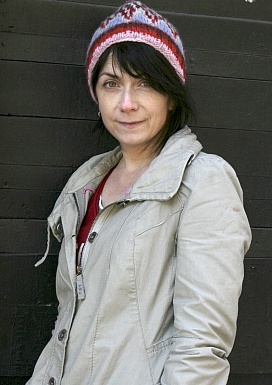I’m a candidate for an MFA in creative fiction at Fairfield University. The program places a clear emphasis on literary fiction (think James Baldwin, not James Rollins.) So I was shocked when my mentor (short story writer Al Davis), recommended that I read a genre mystery – Scottish writer Denise Mina’s Field of Blood – as part of my literary training. “She uses a lot of literary elements,” he told me.
Al was right. Field of Blood is a thriller and a mystery, but it was beautifully written. It was recommended to me, I think, because it’s about a reporter, and at the time, I was working on a piece about a journalist. But I recommend it to anyone, not only because of all the lovely Scottishness in the book, but because it’s a very well-told story. Below the page break is the craft essay I wrote for Al about one of Mina’s literary elements: description.
Denise Mina’s use of description in Field of Blood
There’s no denying it. Denise Mina’s Paddy Meehan novels are commercial, genre fiction. There’s something about the suspense, the way the plot skips along briskly, moved forward by external events, and even something about the narrative voice that makes me want to classify Field of Blood and its two sequels as summer beach reads and move on.
Such a classification, however, would neither be fair to the novel nor to Mina, whose prose is far more literary than that of other contemporary thriller-writers: James Rollins or Andrew Gross, for example. Mina’s skill is in her quick, elegant descriptions. She sums up people, places and situations with vivid details, not lingering over the description, but punching it, and then briskly moving on :
“He was a skinny, agitated man, all angles. He lived on a diet of sugar and whiskey.” p. 18
“The day gleamed through the windows but the sunlight didn’t temper the room.” p. 97
“A pall of sticky shame hung over the newsroom, implicating everyone…” p. 125
According to Josip Novakovich, author of The Fiction Writer’s Workshop, such brevity can be a good thing, particularly in a novel that’s paced as quickly as Mina’s:
When descriptions drag, the problem usually lies not in the setting, but in presenting the setting too slowly. Make your descriptions dynamic and quick; give bits of setting concurrently with characters and action. p. 27
Mina certainly does that. The very first thing that struck me about Field of Blood was the way she described the newsroom of the Scottish Daily News. The newsroom in Field of Blood is one of the novel’s most important settings. According to Novakovich, setting provides the groundwork for fiction; out of place, he writes, character is formed.
This approach could be expressed as Setting + Character = Plot. Out of a character’s relationship with the setting, or out of the character’s conflict with the setting, you get the plot (or at least a part of the plot, or a dynamic backdrop for your plot.) P. 29
That is certainly the case for Paddy and the newsroom of the Scottish Daily News. Paddy works in the newsroom, but she’s not fully a part of it yet. She wants desperately to be a full journalist, but when she’s in the newsroom, she’s forever, bringing coffee and office supplies to the actual journalists. Her proximity to what she wants does generate the internal part of the plot — Paddy’s desire to embark upon a career in journalism.
It was Mina’s description of the newsroom that most struck me when I read the book. As a reader, I clearly envisioned the newsroom to which Mina’s protagonist so badly wants to belong. As a reporter, I was startled by a description of a newsroom that almost identical to the one I worked in when I was Paddy Meehan’s age.
However, when I flipped through the novel trying to find the passages of description that had created this impression, I was only able to come up with one real paragraph that is completely devoted to describing the newsroom.
The cavernous newsroom was divided into three sections, one for sports, one for news and another for features. A large table sat at the center of each section, heavy gray Atex typewriters and blank workspaces laid out for the editors. Each desk had a different character: features considered itself intellectual, news was pompous and self-important, and sports was the good-time gal of the floor, the desk where they always had nice cakes and a laugh and seemed to be perpetually chewing indigestion tablets that they left out on the table. p. 46
It’s a short paragraph. Even though the newsroom is the setting for a good deal of the action and although this particular setting is an important one for her protagonist, Mina does not dwell on the chore of describing the newsroom in its entirety. She’s given us the barest facts as a foundation. Later, when anything happens in the newsroom, Mina builds a bit on this initial description; adding spare desks, windowsills where copyboys, sit smoking, lifts that are forbidden to the employees of the newsroom, and peopling the room with journalists who sit with their feet on the desks. By the end of the story, we have a complete picture of the room, although thanks to that first paragraph we have a good sense of what the newsroom is like all along.


Leave a Reply
Want to join the discussion?Feel free to contribute!